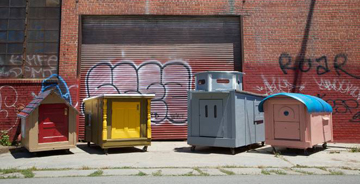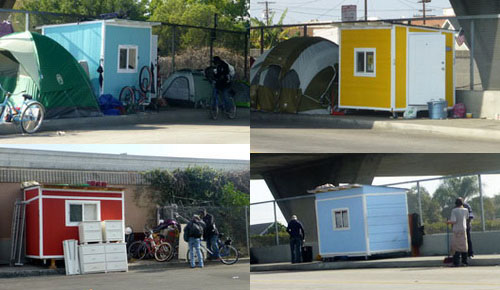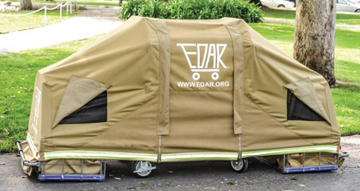City Seizes Tiny Houses from Homeless Occupants
Leslie Evans
On February 12, at the request of City Councilmember Curren Price, city workers seized three of the four tiny houses on wheels for the homeless pictured above. They were located on the 42nd Street bridge over the Harbor Freeway and around the corner on Flower Street. One escaped by being rolled away by its owner. We telephoned Elvis Summers on February 15. He built the little structures and donated them to homeless people. He said the residents were not permitted to remove their belongings, including medications, before the structures were loaded on trucks and taken away. The houses are stored on a city lot. They had been slated for demolition but it appears that protests have led to city to begin a discussion of whether to go ahead with that plan. Seven more are scheduled to be seized.
The little 6 x 10 foot wheeled structures have become one focal point in the city’s uneasy balancing act between trying to find other accommodations for people living on the streets and simply dismantling their camps and seizing their property.
West Adams resident Elvis Summers’ first house, smaller than the ones above (and denounced as a “dog house” by City Councilmember Joe Biscaino), was for one of my homeless neighbors, a 60-year-old black woman called Smokie, who I have known for a few years.
Summers made a video of the project. It was viewed on YouTube by 6 million people. A GoFundMe effort raised more than $100,000 and Summers has gone full-time building more, and larger, versions. So far, he told me, he has built and given away 37 of them. These larger ones not only have a window and a deadbolt lock for the door, but a solar panel on the roof capable of powering a microwave or other small appliances.
Here is a video about his efforts by TV’s Inside Edition:
https://www.youtube.com/watch?v=oq6yEjQoHp4.
Summers says his houses were inspired by a similar project by Oakland artist and contractor Gregory Kloehn.

Gregory Kloehn’s tiny houses in Oakland, California. Highly praised, these are made from random scrap and are literally about the size of dog houses. Elvis Summers’ houses are much larger and made from new lumber.
Here are a couple of very favorable articles on Kloehn’s work:
and:
http://nationswell.com/gregory-kloehn-homes-on-wheels-for-homeless/
Supporters of the homeless, and of course, the recipients of the tiny houses, think Summer’s project is great. The City Council and the City Attorney’s office have been much more negative. At an August meeting of the City Council, Senior Assistant City Attorney Valerie Flores advised the body that the houses don’t qualify as personal belongings but can be seized and destroyed as mere “bulky items,” like cast-off furniture. They are not street legal, and not legal as living quarters on private property because they lack electricity and plumbing. Flores said the city could be sued if someone living in one was injured.
Elvis Summers has retained attorneys from the ACLU to defend the homeless owners’ right to keep their little houses. So far only the three at 42nd and Flower have been confiscated but more are set to go.
If the law begins from the zoning code, then these little structures don’t meet standards either as vehicles to remain in the street or as houses to be parked and lived in on land. But it is a little bizarre to use these codes for people that have neither vehicles nor houses: 31,000 of the county’s 44,000 homeless live in the streets. Many live in tents. RVs, while they are vehicles, usually when owned by the homeless do not have running water or electricity and so do not meet code as habitations. And an endless variety of shelters and shacks are built out of many materials. At least the tiny houses are portable.
The counter law to the vehicle and housing codes is the law protecting private property, which applies to the homeless as well as to the better off. The wheeled tiny wooden houses are containers for homeless property, not empty “bulky items” such as sofas and chairs.
Ninth Circuit Court ordered protection for homeless wheeled shelters
The Ninth Circuit Court of Appeals in 2012 rendered a decision on city seizures of homeless property. They ruled that unattended homeless personal property, much less when the owner is standing right there, is protected from seizure under the Fourth and Fourteenth Amendments to the Constitution. The court made a special point of singling out as examples EDARs, which they defined as “small, collapsible mobile shelters provided to homeless persons by Everyone Deserves a Roof, a nonprofit organization.” The city had been seizing and destroying EDARs. The court commented: “EDARs are intended to address the chronic shortage of housing faced by homeless persons in Los Angeles. Former Los Angeles City Mayor Richard Riordan spent the night of Saturday, November 6, 2010, in an EDAR on Skid Row to demonstrate how the shelters could be used by the homeless population residing there.”
The reason the EDAR got special attention from the court, and why this deserves comparison with Elvis Summers’ little houses on wheels, was that the EDAR is an entirely enclosed shelter on wheels, which makes it possible to clearly identify what are the homeless person’s private possessions, not always evident in a homeless camp situation, and also makes it possible for the owner to move the structure when needed or required.
A Compromise Solution
Of course, no one wants the tiny houses to fill up our streets, any more than we are in favor of the proliferation of homeless tents. But it is pointless to focus on their deficiencies compared to real houses instead of their advantages as compared to a blanket or a tent. No one is offering the 31,000 living on the street many houses or apartments, so their real choice is between the blanket and the tiny house.
The tiny house is waterproof with a shingle roof. It has a solid wood door with a deadbolt lock to provide security to the homeless person when inside and to protect their possessions when they are out. They have a window and door for ventilation, and can have a real mattress on the floor to sleep on. They have wheels, so can be moved when needed, and keyed wheel locks to prevent theft.
The City Council and the Mayor have been talking for months about finding city-owned empty lots in which to set up showers and portable toilets and allow homeless citizens living in RVs to camp. This is the obvious place to put the tiny houses, and has been loudly advocated by Elvis Summers. This would solve the problem of having these structures on sidewalks or in the streets, while providing better shelter and privacy than the residents had before, or that the city is prepared to provide for many years to come, if at all.
Longtime skid row activist Alice Callaghan praised the houses because they offer the homeless privacy:
“Who wants to live their life in full public view? Unless the city has an alternative, it seems to me simply immoral for the city to tell people they have to move their four walls if they have nowhere to move them to.” (LA Times Aug 25, 2015)
The Times on Feb 25 said Mayor Garcetti “is committed to getting homeless people into permanent and not makeshift housing.” The city did not offer any housing to the people whose Tiny Houses they seized, their housing plan has no funding, and if it did would take 10 years to deliver. The Times also spoke to Johnny Horton, a 60-year-old diabetic whose legs are covered with bandaged wounds. He was in tears when his little house was seized and he has to go back to sleeping on the sidewalk. “Laying on that tent on the sidewak it’s impossible to keep clean,” Horton told the reporter.
Elvis Summers brought a truck and took eight of his little houses to a church parking lot in Compton and other places. Some are in nearby cities presumably out of reach of the LA Sanitation Department. The Times ran a full-page story on the Tiny House seizure February 27. It said the Curren Price told them that the houses are dangerous, that a firearm and drugs had been found in one, and that the occupants had been offered shelter but had refused. At least two of the seized houses were occupied by married couples, one with their dog Cowboy. Elvis Summers responded that drug use predated the appearance of his houses and should have nothing to do with their worth. As for shelters, many have a 3-5 day limit, or at best 30 days. Many require a religious conversion to be served. If you have possessions or a pet you will lose them to accept a temporary bed in a room with wall to wall cots. The offer is of such limited time at such high cost that most long-term homeless will invariably reject it.
Comments
Leave a Reply
You must be logged in to post a comment.






